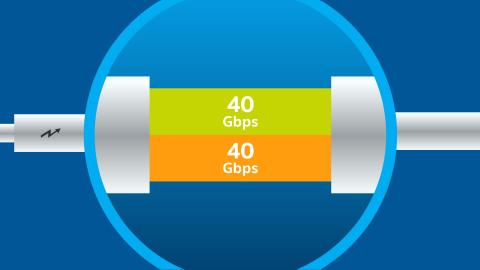By Majeed Ahmad, contributing editor
A new interconnect ecosystem is in the making after Intel’s announcement to integrate Thunderbolt 3 onto future processors and make the high-speed cabling interface royalty-free. Intel’s move is expected to significantly lower the cost and power consumption and make Thunderbolt truly plug-and-play.
The integration of Thunderbolt into Intel CPUs will most likely lead to greater adoption of the 40-Gbps port. For a start, a single port for powering devices and connecting to 4K peripherals is a powerful selling point in notebook computer designs.

Image: Intel.
Next, the baking of Thunderbolt controller into CPUs will lower power consumption as well as cost. Presently, a Thunderbolt chip can cost from $5 to $8, and it adds nearly 10% power, which significantly impacts the battery life.
And the fact that third-party suppliers will now be able to develop Thunderbolt-capable controllers for storage, docks, displays, etc. without a royalty fee will inevitably lead to more accessories. That, in turn, will further bring down the cost of Thunderbolt accessories ranging from expansion docks to external storage devices.
USB Type-C and Thunderbolt: happy together
Here at this Thunderbolt technology crossroads, it’s worth mentioning the entangled relationship between Thunderbolt and USB Type-C standards. Intel’s high-speed cabling interface, initially developed in collaboration with Apple to eliminate cable clutter, remained on the fringes until 2015, when Intel made Thunderbolt 3 a superset of USB Type-C specification.
That quickly began opening new doors for this costly and closed-interface design. The zippy Thunderbolt 3 built on top of USB Type-C cabling interface gradually started inching toward the mainstream with super-fast 40-Gbps data transfer.

Image: Intel.
However, higher costs and varying plug-and-play capabilities on either side of the connection were still a major obstacle in greater adoption. Then, in May 2017, came Intel’s call for simplifying Thunderbolt hardware by integrating it into CPUs. And Intel vowed to free it from royalty restrictions.
That, along with the universal appeal of the USB ecosystem, is expected to encourage more accessory suppliers to join the Thunderbolt bandwagon. A unified cable design supporting 4K drone videos and virtual reality streams will most likely encourage more suppliers to build Thunderbolt-compatible chips for a variety of accessories.
So expect this development to be followed by a stream of announcements from cable and connector suppliers launching Thunderbolt accessories such as single-cable docks and external drives.
Advertisement





